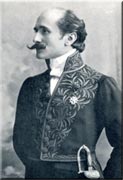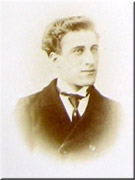![]()
Poet
| He thus expressed his feelings to Edmond Rostand not by a letter which would have seemed banal and conventional to him, but in verses which were springing up more and more in his mind; he could better express everything he felt.
“… In 1902 I had to send him the ingenuous poem in which I signified my fervent admiration to him in vehement terms. A few weeks passed, where I still feverishly awaited a response, which did not come. I finally had her, she intoxicated me. After compliments, the poet announced to me that he was sending my verses to “Gaulois du Dimanche” to be published there. The letter was drawn in the large handwriting, which I have since come to know, of Madame Edmond Rostand, handwriting which moreover resembled her husband’s so much that it could be confused. “ This is how Edmond Rostand befriended him and encouraged him to continue down this path. It was he who helped him to publish his first collection of verses in 1904 when he was finishing his studies “the White Road“, of which he suggested the title. |
 Edmond ROSTAND 1868-1918 |
Twice the Académie Française will crown his works. “The White Road” led him in 1908 to the shores of the “Gulf of Love”. This gulf of love is the gulf of La Ciotat. Provençal patriot, Émile Ripert loves his birthplace. It was during his meditative walks in the heart of the hills and on the rocky ridges between the Bec de l’Aigle and Cassis, or on the beach of Les Lèques, that Émile Ripert obeyed an inspiration whose spontaneity is reflected in his descriptions.
It was in 1912 that La Terre des Lauriers won the national poetry prize in which he made a profession of love for his native town of La Ciotat.
“City of my first and clearest years,
You are sweet to me beyond the sweetest things. ”
| |
In the “Gulf of Love” and “the land of Laurels” he sings the history of Provence, its legends and its glory.
On the sands of the Gulf of Love, intoxicated by the scent of Laurels of Provence, slept a Homeric siren, whose lethargy, more than a thousand years old, was disturbed by the cannon across the Rhine of 1914. This mythological heroine was wounded on the Mediterranean shores, and the “wounded siren” in 1920 is an exaltation of effervescent patriotism, born from the atrocities of submarine warfare.
Émile Ripert was then attracted by the great physiognomy of this saint of integral pacifism, Francis of Assisi. He reopened the notes he had taken during his pilgrimage to Umbria in 1907 and gave “the poem of Assisi” in 1924. It is the very soul of St Francis that vibrates ![]() in “the poem of Assisi”
in “the poem of Assisi”
TO BE CONTINUED…
|
* poem from the collection “Le chemin blanc” 1904 |
|
Links to pages including animation are |


